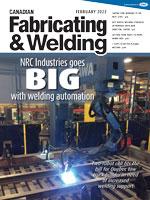- FMA
- The Fabricator
- FABTECH
- Canadian Metalworking
The flexibility of left- and right-hand bending
New features expand tube bending capabilities
- March 24, 2023
- Article
- Fabricating

BLM's E-TURN40 offers in process right- and left-handed bends, fixed and variable radius, flat, edge, or inclined section, single or multi-radius, process round, oval, and rectangular tube, pre-machined with holes and slots.
As fabricators look to become more efficient and as flexible as possible, tube bending machine manufacturers have adapted the machines to meet everyday requirements.
Many of the latest machines offer both left-hand and right-hand bending, while some machines can be converted from one to the other.
“Having this feature is important when bending complex geometries,” said Robert Bowden, North American product manager – bender systems, BLM GROUP USA. “There are some parts that if you try to bend it on just a left-hand or right-hand machine, at some point, the tube will interact with machine or the floor. The machine configuration doesn't allow you to fully bend that part. The left hand and right hand within process allows more complex geometry.”
This is especially important for furniture manufacturers, who see a lot of symmetrical and mirror shapes. For example, if a fabricator is producing a chair, there is often a left-hand side of a chair and a right-hand side of a chair that are basically identical, but mirror image. While fabricators can have no trouble producing one side of the chair, the other side of the chair can be problematic without the ability to switch over from left- to right-hand bending.
Fabricators that are making furniture, like chair frames, tend to bend parts in a kit, making all the components for one chair before moving onto the next rather than batching the same parts. The ability to switch between left- and right-sided bending with the touch of a button during the process eliminates setup changes and downtime.
“Having the ability to switch from the left hand to the right hand within a process is a huge advantage because the time it takes to mechanically change a machine over can sometimes be 45 minutes to an hour,” said Bowden. “This is not time well spent, and fabricators don't want to be doing that on a daily basis.”
The other advantage is that machines with this feature provide more tooling capabilities. Rather than using it for complex or mirror geometries, fabricators can mount multiple sets of tools to the machine. This means that the tools are already set up when needed, and the time needed for changeover is reduced.
“Customers that are more of a job shop, where they don't know what kind of part is going to come across their desk, they want to just have the most flexible machine possible,” said Bowden.
Check out out latest feature on how fabricators can take tube bending to the next level
subscribe now


Keep up to date with the latest news, events, and technology for all things metal from our pair of monthly magazines written specifically for Canadian manufacturers!
Start Your Free Subscription- Industry Events
MME Saskatoon
- May 28, 2024
- Saskatoon, SK Canada
CME's Health & Safety Symposium for Manufacturers
- May 29, 2024
- Mississauga, ON Canada
DiPaolo Machine Tools Open House 2024
- June 4 - 5, 2024
- Mississauga, ON Canada
FABTECH Canada
- June 11 - 13, 2024
- Toronto, ON Canada
Zoller Open House & Technology Days 2024
- June 12 - 13, 2024
- Ann Arbor, MI




















